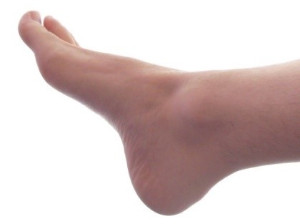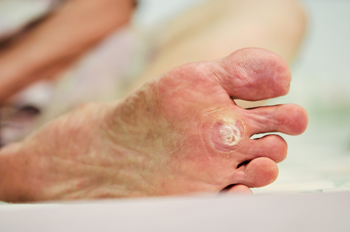Items filtered by date: December 2021
How to Ease Foot Pain While Pregnant
 Pregnant women often deal with various foot-related issues because of the added weight when carrying a baby. One of the most common foot-related issues during pregnancy is swollen feet. This occurs when there is an excess of fluid that builds up and travels down to the feet. Because of this, raising and elevating the feet as much as possible, as well as wearing wide comfortable shoes, can help reduce the swelling. Arch pain is another common issue in pregnancy and can be eased by stretching the feet in the morning as well as after exercise. Ingrown toenails may also develop during during pregnancy, and they are another reason why wearing wide shoes is important. Pregnant women who get ingrown toenails or are struggling with other foot-related issues and pain may wish to consult with a podiatrist for suggested treatment options.
Pregnant women often deal with various foot-related issues because of the added weight when carrying a baby. One of the most common foot-related issues during pregnancy is swollen feet. This occurs when there is an excess of fluid that builds up and travels down to the feet. Because of this, raising and elevating the feet as much as possible, as well as wearing wide comfortable shoes, can help reduce the swelling. Arch pain is another common issue in pregnancy and can be eased by stretching the feet in the morning as well as after exercise. Ingrown toenails may also develop during during pregnancy, and they are another reason why wearing wide shoes is important. Pregnant women who get ingrown toenails or are struggling with other foot-related issues and pain may wish to consult with a podiatrist for suggested treatment options.
Pregnant women with swollen feet can be treated with a variety of different methods that are readily available. For more information about other cures for swollen feet during pregnancy, consult with one of our podiatrists from Palmetto Podiatry Group of Anderson. Our doctors will attend to all of your foot and ankle needs.
What Foot Problems Can Arise During Pregnancy?
One problem that can occur is overpronation, which occurs when the arch of the foot flattens and tends to roll inward. This can cause pain and discomfort in your heels while you’re walking or even just standing up, trying to support your baby.
Another problem is edema, or swelling in the extremities. This often affects the feet during pregnancy but tends to occur in the later stages.
How Can I Keep My Feet Healthy During Pregnancy?
- Wearing orthotics can provide extra support for the feet and help distribute weight evenly
- Minimize the amount of time spent walking barefoot
- Wear shoes with good arch support
- Wear shoes that allow for good circulation to the feet
- Elevate feet if you experience swelling
- Massage your feet
- Get regular, light exercise, such as walking, to promote blood circulation to the feet
If you have any questions please feel free to contact our office located in Anderson, SC . We offer the newest diagnostic and treatment technologies for all your foot and ankle needs.
What Causes a Swollen Ankle?
When your ankle appears to be larger than normal it may be an indication of fluid retention or an injury. The skin becomes tight and stretched out, and the area may be painful, especially when standing or walking. Causes of swelling may include being overweight, poor circulation, pregnancy, blood clots, arthritis, or injury. Taking certain prescription medication can also be a causative factor. Swelling in the leg or ankle could be caused by inflammation from an injury such as an ankle sprain, a broken bone, a ruptured tendon, or torn ligament. Mild swelling or edema can be caused by pregnancy, premenstrual cramps, consuming too much salt, or standing for extended periods of time. If your ankle is swollen or painful, it is suggested to consult with a podiatrist as soon as possible for a full diagnosis and appropriate treatment plan.
Ankle pain can have many different causes and the pain may potentially be serious. If you have ankle pain, consult with one of our podiatrists from Palmetto Podiatry Group of Anderson. Our doctors will assess your condition and provide you with quality foot and ankle treatment.
Ankle pain is any condition that causes pain in the ankle. Due to the fact that the ankle consists of tendons, muscles, bones, and ligaments, ankle pain can come from a number of different conditions.
Causes
The most common causes of ankle pain include:
- Types of arthritis (rheumatoid, osteoarthritis, and gout)
- Ankle sprains
- Broken ankles
- Achilles tendinitis
- Achilles tendon rupture
- Stress fractures
- Tarsal tunnel syndrome
- Plantar fasciitis
Symptoms
Symptoms of ankle injury vary based upon the condition. Pain may include general pain and discomfort, swelling, aching, redness, bruising, burning or stabbing sensations, and/or loss of sensation.
Diagnosis
Due to the wide variety of potential causes of ankle pain, podiatrists will utilize a number of different methods to properly diagnose ankle pain. This can include asking for personal and family medical histories and of any recent injuries. Further diagnosis may include sensation tests, a physical examination, and potentially x-rays or other imaging tests.
Treatment
Just as the range of causes varies widely, so do treatments. Some more common treatments are rest, ice packs, keeping pressure off the foot, orthotics and braces, medication for inflammation and pain, and surgery.
If you have any questions, please feel free to contact our office located in Anderson, SC . We offer the newest diagnostic and treatment technologies for all your foot care needs.
Arthritis Can Cause Pain in the Feet and Ankles
Exercising to Improve Foot Health
 If you get tired from walking or standing for long periods, you may need to perform some simple exercises to strengthen the feet and legs. This exercise can help keep your ankles active and improve circulation as well. Begin by sitting in a straight-backed chair with both feet on the floor. Raise one leg so it’s parallel to the floor and rotate your ankle clockwise in a circular motion. Repeat this motion rotating your ankle counterclockwise. Then flex your toes straight out away from your body and then back towards yourself. Be sure to alternate each leg and foot. Next with your feet flat on the floor, raise your heels and hold for a few seconds, keeping your toes on the floor. You can also try this while pressing lightly on the knees to add a bit of resistance. Another great exercise is toe raises. Instead of lifting the heels, this time lift the toes and keep your heels on the floor. Making these simple exercises a part of your daily routine can strengthen the feet and ankles over time. If you have a foot or ankle condition, or any serious health issues, please be sure to check with a podiatrist before starting any new exercise programs.
If you get tired from walking or standing for long periods, you may need to perform some simple exercises to strengthen the feet and legs. This exercise can help keep your ankles active and improve circulation as well. Begin by sitting in a straight-backed chair with both feet on the floor. Raise one leg so it’s parallel to the floor and rotate your ankle clockwise in a circular motion. Repeat this motion rotating your ankle counterclockwise. Then flex your toes straight out away from your body and then back towards yourself. Be sure to alternate each leg and foot. Next with your feet flat on the floor, raise your heels and hold for a few seconds, keeping your toes on the floor. You can also try this while pressing lightly on the knees to add a bit of resistance. Another great exercise is toe raises. Instead of lifting the heels, this time lift the toes and keep your heels on the floor. Making these simple exercises a part of your daily routine can strengthen the feet and ankles over time. If you have a foot or ankle condition, or any serious health issues, please be sure to check with a podiatrist before starting any new exercise programs.
Exercising your feet regularly with the proper foot wear is a great way to prevent injuries and build strength. If you have any concerns about your feet, contact one of our podiatrists from Palmetto Podiatry Group of Anderson. Our doctors can provide the care you need to keep you pain-free and on your feet.
Exercise for Your Feet
Exercise for your feet can help you gain strength, mobility and flexibility in your feet. They say that strengthening your feet can be just as rewarding as strengthening another part of the body. Your feet are very important, and we often forget about them in our daily tasks. But it is because of our feet that are we able to get going and do what we need to. For those of us fortunate enough to not have any foot problems, it is an important gesture to take care of them to ensure good health in the long run.
Some foot health exercises can include ankle pumps, tip-toeing, toe rises, lifting off the floor doing reps and sets, and flexing the toes. It is best to speak with Our doctors to determine an appropriate regimen for your needs. Everyone’s needs and bodies are different, and the activities required to maintain strength in the feet vary from individual to individual.
Once you get into a routine of doing regular exercise, you may notice a difference in your feet and how strong they may become.
If you have any questions please feel free to contact our office located in Anderson, SC . We offer the newest diagnostic and treatment technologies for all your foot and ankle needs.
How Can I Get Rid of Warts on My Feet?
 If you spend a lot of time in gym locker rooms or at swimming pools, you may end up noticing growths on the bottom of your feet. These are known as plantar warts. They are caused by a virus (human papillomavirus or HPV) that infects the soles of your feet. HPV is transmitted by direct contact, and an open sore or crack on the feet may increase your chances of infection. The wart looks like a flat spot on the skin with a depressed area in the center. It may be yellow and have a black spot in the middle. Treatments include applying salicylic acid to the area, liquid nitrogen to freeze the wart, or simply having the wart removed surgically. Plantar warts have a habit of coming back, so adhering to treatment is essential. Prevention techniques include wearing foot coverings in pools, locker rooms, or dorms, as well as keeping the infected area covered and washing your hands frequently to avoid spreading the virus to other parts of your body. To find out more about the treatment and removal of plantar warts, a visit to a podiatrist is highly suggested.
If you spend a lot of time in gym locker rooms or at swimming pools, you may end up noticing growths on the bottom of your feet. These are known as plantar warts. They are caused by a virus (human papillomavirus or HPV) that infects the soles of your feet. HPV is transmitted by direct contact, and an open sore or crack on the feet may increase your chances of infection. The wart looks like a flat spot on the skin with a depressed area in the center. It may be yellow and have a black spot in the middle. Treatments include applying salicylic acid to the area, liquid nitrogen to freeze the wart, or simply having the wart removed surgically. Plantar warts have a habit of coming back, so adhering to treatment is essential. Prevention techniques include wearing foot coverings in pools, locker rooms, or dorms, as well as keeping the infected area covered and washing your hands frequently to avoid spreading the virus to other parts of your body. To find out more about the treatment and removal of plantar warts, a visit to a podiatrist is highly suggested.
Plantar warts can be very uncomfortable. If you need your feet checked, contact one of our podiatrists from Palmetto Podiatry Group of Anderson. Our doctors will assist you with all of your foot and ankle needs.
About Plantar Warts
Plantar warts are the result of HPV, or human papillomavirus, getting into open wounds on the feet. They are mostly found on the heels or balls of the feet.
While plantar warts are generally harmless, those experiencing excessive pain or those suffering from diabetes or a compromised immune system require immediate medical care. Plantar warts are easily diagnosed, usually through scraping off a bit of rough skin or by getting a biopsy.
Symptoms
- Lesions on the bottom of your feet, usually rough and grainy
- Hard or thick callused spots
- Wart seeds, which are small clotted blood vessels that look like little black spots
- Pain, discomfort, or tenderness of your feet when walking or standing
Treatment
- Freezing
- Electric tool removal
- Laser Treatment
- Topical Creams (prescription only)
- Over-the-counter medications
To help prevent developing plantar warts, avoid walking barefoot over abrasive surfaces that can cause cuts or wounds for HPV to get into. Avoiding direct contact with other warts, as well as not picking or rubbing existing warts, can help prevent the further spread of plantar warts. However, if you think you have developed plantar warts, speak to your podiatrist. He or she can diagnose the warts on your feet and recommend the appropriate treatment options.
If you have any questions please feel free to contact our office located in Anderson, SC . We offer the newest diagnostic and treatment technologies for all your foot and ankle needs.
Why Does the Top of My Foot Hurt?
Pain in the top of the foot could have many potential causes. If the pain is accompanied by swelling, bruising, and began after a period of intense or repetitive exercise, it may be due to a stress fracture or sprained metatarsal. Chronic pain, swelling, and stiffness, along with a crackling sensation when you move the foot or a lump along the tendon may be a sign of tendonitis or osteoarthritis. Pain that is sudden and severe, starts near the bottom of the big toe, and is accompanied by redness, swelling, and warmth could be a sign of gout. If you are suffering from pain in the top of the foot, it is strongly suggested that you seek the care of a podiatrist.
Foot Pain
Foot pain can be extremely painful and debilitating. If you have a foot pain, consult with one of our podiatrists from Palmetto Podiatry Group of Anderson. Our doctors will assess your condition and provide you with quality foot and ankle treatment.
Causes
Foot pain is a very broad condition that could be caused by one or more ailments. The most common include:
- Bunions
- Hammertoes
- Plantar Fasciitis
- Bone Spurs
- Corns
- Tarsal Tunnel Syndrome
- Ingrown Toenails
- Arthritis (such as Gout, Rheumatoid, and Osteoarthritis)
- Flat Feet
- Injury (from stress fractures, broken toe, foot, ankle, Achilles tendon ruptures, and sprains)
- And more
Diagnosis
To figure out the cause of foot pain, podiatrists utilize several different methods. This can range from simple visual inspections and sensation tests to X-rays and MRI scans. Prior medical history, family medical history, and any recent physical traumatic events will all be taken into consideration for a proper diagnosis.
Treatment
Treatment depends upon the cause of the foot pain. Whether it is resting, staying off the foot, or having surgery; podiatrists have a number of treatment options available for foot pain.
If you have any questions, please feel free to contact our office located in Anderson, SC . We offer the newest diagnostic and treatment technologies for all your foot care needs.



